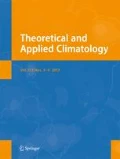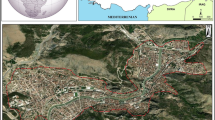Abstract
Climate and weather conditions are the most important factors that influence activities and human health. Bioclimatology/biometeorology are concerned with the study of weather effects on living creatures, including humans, plants, and animals. This research was prepared in order to understand the bioclimatic condition of Kermanshah and its relation to the level of hospital admissions of cardiovascular patients in this city. In addition to the climatic variables, the statistics on the number of daily admissions of cardiovascular patients in Kermanshah during March 27, 2009 to April 30, 2015 was prepared. First, Kermanshah’s bioclimatic conditions were identified on a daily basis. Then, the relationship between each of the thermal sensations with the level of hospital admissions of cardiovascular patients in Kermanshah using Levene’s test, univariate analysis of variance (ANOVA), Scheffe and Games-Howell post hoc tests was investigated. The results of this study showed that in each index, only very few bioclimatic conditions have had an impact on the increase of hospital admissions of cardiovascular diseases. For example, based on the equivalent temperature index (Tek or EqT), there is a significant relationship between extreme conditions and the rate of cardiovascular admissions. But, however, in the effective temperature index (TE), a significant correlation between warm/hot conditions and an increase in the number of cardiovascular admissions was seen. Based on the predicted mean vote (PMV) and physiological equivalent temperature (PET) indices, cool and cold conditions more than warm and comfort conditions have an effect on the number of hospital admissions of cardiovascular patients. Overall, the obtained results showed that the extreme climatic conditions were directly related to an increase in cardiovascular disease in Kermanshah.


Similar content being viewed by others
References
Abrignani MG, Corrao S, Biondo GB, Lombardo RM, di Girolamo P, Braschi A, di Girolamo A, Novo S (2012) Effects of ambient temperature, humidity, and other meteorological variables on hospital admissions for angina pectoris. J Prev Cardiol 19(3):342–348
Barnett AG (2007) Temperature and cardiovascular deaths in the US elderly: changes over time. Epidemiology 18(3):369–372. https://doi.org/10.1097/01.ede.0000257515.34445.a0
Barnett AG, Dobson AJ, McElduff P, Salomaa V, Kuulasmaa K, Sans S, WHO MONICA Project (2005) Cold periods and coronary events: an analysis of populations worldwide. J Epidemiol Commun Health 59(7):551–557
Bayentin L, El Adlouni S, Ouarda TBMJ, Gosselin P, Doyon B, Chebana F (2010) Spatial variability of climate effects on ischemic heart disease hospitalization rates for the period 1989-2006 in Quebec, Canada. Int J Health Geogr 9:1–5
Bedford, T; 1951. Equivalent temperature, what it is, how it’s measured. Heating, Piping, Air Conditioning. Aug. pp. 87–91
Braga AL, Zanobetti A, Schwartz J (2002) The effect of weather on respiratory and cardiovascular deaths in12 U.S. cities. J Environ Health Perspect 110(9):859–863
Breitner S, Wolf K, Peters A, Schneider A (2014) Short-term effects of air temperature on cause-specific cardiovascular mortality in Bavaria, Germany. J Heart 100(16):1272–1280
Douglas AS, Dunnigan MG, Allan TM, Rawles JM (1995) Seasonal variation in coronary heart disease in Scotland. J Epidemiol Commun Health 49(6):575–582
Dufton A.F; 1932. Equivalent temperature and its measurement, B R technical paper 13. HMSO.
Dufton AF (1933) The use of kata thermometers for the measurement of equivalent temperature. J Hyg Camb 33(03):349–352. https://doi.org/10.1017/S0022172400018647
Gulyás Á, Matzarakis A (2007) Selected examples of bioclimatic analysis applying the physiologically equivalent temperature in Hungary. ACTA CLIMATOLOGICA ET CHOROLOGICA 40-41:37–46
Höppe PR (1999) The physiological equivalent temperature-a universal index for the biometeorological assessment of the thermal environment. Int J Biometeorol 43(2):71–75
Jie Y, Houjin H, Mengxue Y, Wei Q, Jie X (2014) A time series analysis of meteorological factors and hospital outpatient admissions for cardiovascular disease in the Northern district of Guizhou Province, China. Braz J Med Biol Res 74(8):689–696
Kunst AE, Groebhof F, Mackenbach JP (1994) The association between two windchill index and daily mortality variation in the Netherlands. Am J Public’s Health 84(11):1738–1742
Laschewski G, Jendritzky G (2002) Effects of the thermal environment on human health: an investigation of 30 years of daily mortality data from SW Germany. Clim Res 21:91–103. https://doi.org/10.3354/cr021091
Levene, H; 1960. In Contributions to probability and statistics: essays in honor of Harold Hotelling, I. Olkin et al. eds., Stanford University Press, pp. 278–292.
Loughnan M, Tapper N, Loughnan T (2014) The impact of “unseasonably” warm spring temperatures on acute myocardial infarction hospital admissions in Melbourne Australia: a city with a temperate climate. J Environ Public Health 2014:1–8. https://doi.org/10.1155/2014/483785
Loughnan ME, Nicholls N, Tapper NJ (2008) Demographic, seasonal, and spatial differences in acute myocardial infarction admissions to hospital in Melbourne Australia. Int J Health Geogr 7(1):42. https://doi.org/10.1186/1476-072X-7-42
Matzarakis A, Mayer H (1997) Heat stress in Greece. Int J Biometeorol 41(1):34–39. https://doi.org/10.1007/s004840050051
Matzarakis A, Mayer H, Iziomon M (1999) Applications of a universal thermal index: physiological equivalent temperature. Int J Biometeor 43(2):76–84. https://doi.org/10.1007/s004840050119
Matzarakis A, Rammelberg J, Junk J (2013) Assessment of thermal bioclimate and tourism climate potential for central Europe, the example of Luxembourg. Theor Appl Climatol 114(1-2):193–202. https://doi.org/10.1007/s00704-013-0835-y
Mivaneh F, Akbari E, Baaghideh M (2014) The relationship between heat and mortality from heart disease, Mashhad University of Medical. Sciences 57:932–942
Mayer H, Hoppe P (1987) Thermal comfort of man in different urban environments. Theor Appl Climatol 38(1):43–49. https://doi.org/10.1007/BF00866252
Ohshige K, Hori Y, Tochikub O, Sugiyama M (2006) Influence of weather on emergency transport events coded as stroke: population-based study in Japan. Int J Biometorol 50(5):305–311
Rajathilakam B, Luk JH, Palaniswamy VA, Allegra JR (2013) The role of thermal stress on CHF admissions in a tropical climate. Tropical Medicine and Surgery 1:145. https://doi.org/10.4172/2329-9088.1000145.
Ramazani Gourbi B (2010) The zoning of human bioclimatic comfort for ecotourism planning in Gilan, Iran South Western of Caspian Sea. Aust J Basic Appl Sci 4(8):3690–3694
Ravljen M, Bilban M, Kajfez-Bogataj L, Hovelja T, Vavpotic D (2014) Influence of daily individual meteorological parameters on the incidence of acute coronary syndrome. Int Environ Res Public Health 11:11616–11626
Rivero A, Bolufe J, Ortiz PL, Rodriguez Y, Reyes MC (2015) Influence of climate variability on acute myocardial infarction mortality in Havana, 2001-2012. Medicc Rev 17(2):14–19
Rocklov J, Forsberg B (2008) The effect of temperature on mortality in Stockholm 1998:2003, a study of lag structures and heatwave effects. Scand J Public Health 36(5):516–523. https://doi.org/10.1177/1403494807088458
Saez M, Sunyer J, Tobias A, Ballester F, Ant JM (2000) Ischaemic heart disease mortality and weather temperature in Barcelona, Spain. Eur J Pub Health 10(1):58–63. https://doi.org/10.1093/eurpub/10.1.58
Sanaei M, Khan Mohammadi M, Mohammadi H (2015) Analysis of the effects of the summer heat wave in 2015 and died risky event synoptic patterns caused by pollution in Tehran. Knowl Hazards 2:67–83
Scheffé H (1959) The analysis of variance. John Wiley and sons, Inc., New York
Seaman MA, Levin JR, Serlin RC (1991) New developments in pairwise multiple comparisons: some powerful and practicable procedures. Psychol Bull 110(3):577–586. https://doi.org/10.1037/0033-2909.110.3.577
Stewart S, McIntyre K, Capewell S, McMurray JJ (2002) Heart failure in a cold climate seasonal variation in heart failure-related morbidity and mortality. J Am College Cardiol 39(5):760–766
Webb L, Bambrick H, Tait P, Green D, Alexander L (2014) Effect of ambient temperature on Australian Northern Territory public hospital admissions for cardiovascular disease among indigenous and non-indigenous populations. Int J Environ Res Public Health 11(2):1942–1959. https://doi.org/10.3390/ijerph110201942
Wilson LA, Gerard Morgan G, Charles Hanigan IH, Johnston F, Abu-Rayya H, Broome R, Gaskin C, Jalaludin B (2013) The impact of heat on mortality and morbidity in the Greater Metropolitan Sydney Region: a case crossover analysis. J Environ Health 12(98). https://doi.org/10.1186/1476-069X-12-98
Zacharias S, Koppe CH, Mucke H-G (2014) Influence of heat waves on ischemic heart diseases in Germany, climate. Vol 2(3):133–152
Author information
Authors and Affiliations
Corresponding author
Rights and permissions
About this article
Cite this article
Mohammadi, B., Karimi, S. The relationship between thermal sensation and the rate of hospital admissions for cardiovascular disease in Kermanshah, Iran. Theor Appl Climatol 134, 1101–1114 (2018). https://doi.org/10.1007/s00704-017-2332-1
Received:
Accepted:
Published:
Issue Date:
DOI: https://doi.org/10.1007/s00704-017-2332-1




